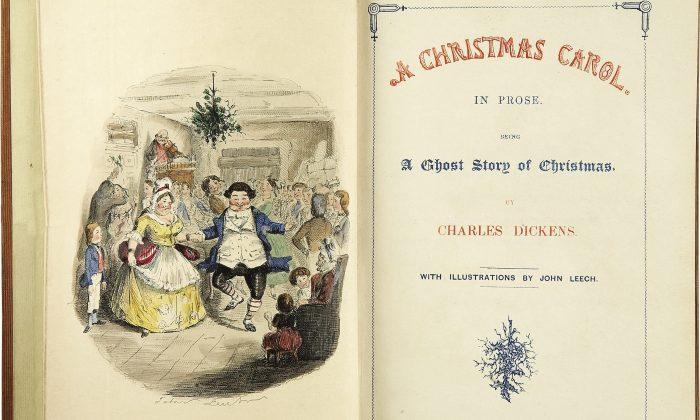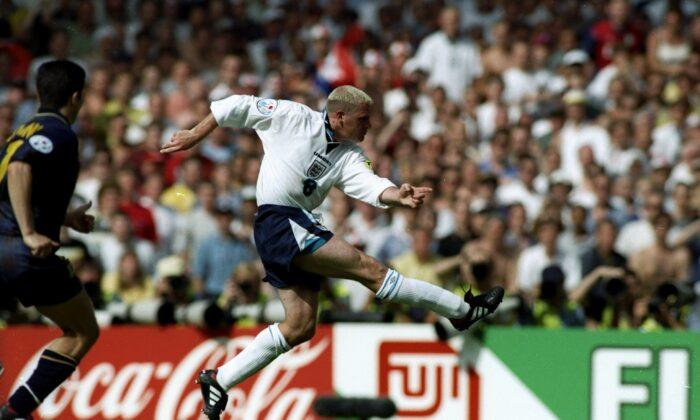Charles Dickens’s “A Christmas Carol” turns 175 years old this month. Dickens did public reading tours. The institution in Reading, United Kingdom, where he gave his lectures is now a Dickens-themed hotel. I live in Reading and I like to have afternoon tea in the “Christmas Carol” room, with its leather wing-backed chairs and benches. Prints from the story, published in December 1843, cover the wood-panelled walls.
Dickens has been called “the man who invented Christmas” (credit also to Prince Albert’s trees and the Victorian penny post). “A Christmas Carol” is a simple tale of a mean-tempered, miserly moneylender who is brought to spiritual redemption by the regretful ghost of his business partner, the bizarre Ghost of Christmas Past, the jolly Ghost of Christmas Present and the shrouded Ghost of Christmas Yet to Come. The eloquence of Dickens’s words seizes one’s attention; every scene is a verbal banquet. Food. Gifts. Song. Church and Chapel. Greenery and garlands. The third chapter, The Second of the Three Spirits, paints a picture of Christmas that remains with us today.
Scents and sparkle fill the air. Flavourful geese, turkeys, oysters, gammon, sausages, punch, cakes, pies, plum puddings, apples, pears, oranges and chestnuts rest on tables. Glistening holly, mistletoe, ivy and red berries decorate the walls. The Ghost of Christmas Present is a giant man dressed in capacious green robes edged in white fur, a holly wreath upon his dark curly hair. His twinkling eyes are “clear and kind” and his voice is full of cheer. One can see the basis of our Father Christmas/Santa Claus in the portrayal. The Ghost carries a torch, representing mirth, and an empty scabbard, representing peace. He lives for only one day, representing the ephemerality of human life. This Ghost has one purpose—to show Ebenezer Scrooge how others live.
The Ghost takes Scrooge on a tour of many households and situations. Under a gloomy, foggy London sky people call out to each other in festive greeting as they shop. Church bells call people to Christmas Eve services. Through many a window the two travellers see gleeful gatherings. Later, it’s off to a stone circle in England’s empty moors where they look upon a miner’s cottage. Here, merriment abounds within four gathered generations. Dressed in their Sunday best, they sing Christmas melodies of yore. This is followed by a trip to the storm-battered coast and heaving seas, where two jovial lighthouse men drink their grog and sailors reminisce about past Christmases spent with kin.
The Cratchits are the epitome of family festivity. Christmas for them is the culmination of their year. The older children, who live at their places of employment, come home for the day. The family has “gussied up” their clothes with ribbons and new collars. Food was a big part of Christmas and important to Dickens. (London’s Charles Dickens Museum is currently hosting an exhibit titled “Food Glorious Food: Dinner With Dickens” Dickens liked his turkey well-roasted). Son Peter mashes the potatoes. Daughter Belinda sweetens the applesauce. Father Bob makes the gin and lemon punch. Mother prepares the roast goose and gravy and decorates the plum pudding with holly, brandy, and flame. Feasting finishes with toasts and tunes. They are “happy, grateful, pleased with one another, and contented with the time.”
Nephew Fred and his new wife are the epitome of festive friendships. Their home is bright with the banter and laughter of unmarried friends. Music and youthful games fill the evening after dining, for “it is good to be children at times, and never better than at Christmas.” Scrooge is pleased with the scene, enjoying himself by proxy. After leaving Fred’s home, Scrooge and the Ghost visit hospitals, workhouses, and jails, where there is cheer in mind if not body, and travellers in foreign lands thinking of home. Only then does Scrooge realize that the Ghost has grown white-haired and haggard; his time on earth is ending.
In the final chapter, a reformed Scrooge, dresses in his best, sends a turkey to the Cratchits (food was a common Victorian gift), and wanders London streets while on his way to church and then his nephew’s home. People are pouring forth out of house and shop, greeting him with a holiday smile which he now returns. “Good morning sir! A Merry Christmas to you!” echoes through the snowy streets. He watches people hurrying about their business, he glances through kitchen windows and observes children at play. Scrooge is inhaling the pure joy of those around him and adding it to his own coffers, surprised “that any walk—that anything—could give him so much happiness.”
Feasting, frivolity, gifting, decorating, and dressing up have been part of human celebrations since time immemorial and should remain so. They are part of our collective and varied heritages. During the festive season, people go to a lot of work to prepare for just one day. Christmas gatherings needn’t be stressful. It’s a time to delight in others’ happiness. Simple things can be pleasurable. We have much to learn from the Ghost of Christmas Present.




